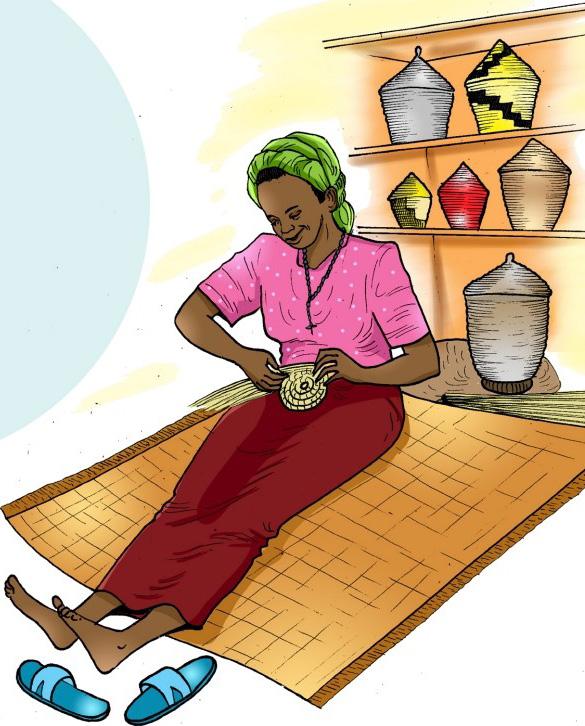
3 minute read
Lesson 4. Decide your pricing
Anchor Scripture:
• Psalms 106:3 Blessed are those who act justly, who always do what is right.
Advertisement
Specific training objectives: By the end of this session, participants will be able to: • Determine costing for product/ services • List considerations made while setting prices
As business people, you have to determine the price for the goods or services that you are selling. There are many things to consider when setting your prices. Let us explore some of them together. Group Exercise – divide participants into at least two groups. Each group may choose one example.
1. Second hand shoes business
A businesswoman gets second hand shoes from Kigali and sells them in her rural shopping centre. Discuss the things she needs to consider when setting her price for a pair of shoes.
2. The Milk Vendor
A vendor is buying a litre of milk at Rwf150, what should be the vendor’s selling price per litre? Discuss some things the milk vendor must consider when setting the selling price for a litre of milk.
Direct and Indirect costs
The cost of the product is the total of all of the costs related to the product/ service. The cost can be divided into two categories:
Direct Costs
These are costs that are directly related to the products or services that the business makes or sells. • Cost of buying the products or material involved in producing the product • The money we pay people who work to make or sell the product • Transport of the materials or product • Any other costs needed to get the product to the customer
Indirect Costs
These are all other costs for running the business, for example rent, license, security, etc. Indirect costs are also known as overheads or fixed expenses. Overhead cost is paid whether the business is producing or not. Calculating costs for business products – expanding the example cases
1. Second hand shoes business
A business woman gets second hand shoes from Kigali and sells them in her rural shopping centre. She buys a bale of 100 second hand pairs of shoes at Rwf300,000. A bale of shoes takes one month to sell. She pays herself a monthly salary of Rwf100,000. She pays Rwf1500 to travel to the city and Rwf2500 back with a bale of shoes once a month. She sells from an open air market and pays Rwf36000 for a one year licence. Work out her cost of one pair of shoes.
Direct cost Cost item Cost per pair
Buying Price Rwf300,000 for 100 shoes Rwf3,000 Travel Cost (to and from city) Rwf4,000 for 100 shoes Rwf40 Woman’s monthly salary Rwf100,000 for 100 shoes Rwf1,000
Indirect cost
Open air license Rwf36,000 for a year=Rwf3,000 per month for 100 shoes Rwf30
Total cost for one pair of shoes Add all cost items/shoe Rwf4,070
2. The Milk Vendor
A milk vendor buys milk from the farmers in town at Rwf150 per litre. The vendor sells 100 litres milk to the customers every day. The vendor uses the services of the bicycle rider and pays Rwf2, 000 for milk collecting and delivering to the nearest bus stop. The vendor gets a bus from the stage to town and pays Rwf 500 for both milk and self. The vendor pays Rwf1, 000 to the young man who helps distribute the milk to the customers every day. After selling, the vendor catches the bus back with the empty can and paysRwf500. The vendor takes a pay of Rwf5000 per day. Other Indirect Cost: Milk vendor’s license is Rwf45, 000 for one year. What is the vendor’s cost of milk per litre?
Direct Cost Cost items Cost per litre Buying price from farmers 150/ltr for 100 ltr = 15,000 150 Bicycle rider service cost 2000 for 100 ltr = 2000 20 Transport to town 500 for vendor and 100ltr 5 milk
Distribution cost 1000 for 100 litres 10
Transport back Vendor’s salary Indirect cost
License 500 for vendor and cans 5
5000 per day for 100 litres 50
45,000 per year=123 per day 1.23
Total cost per litre of milk Add all costs items / litre 241.23
Key learning points
When setting a price for a product one needs to consider the following: • The total product cost (direct and indirect) • Competitors’ prices • How much customers are willing to pay – the most important element! If you cannot get your costs low enough to set a price that customers are willing to pay, it may be time to consider other products









